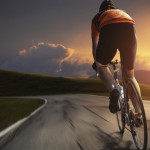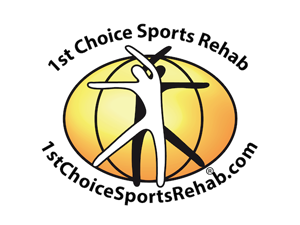Bike Fit: Minimize Injury / Maximize Performance
by Dr. Sasha Stolz
 When I am not treating patients in the office, I spend my evenings and weekends as a triathlon and swimming coach. Unfortunately, one of the worst things that I see happen to my athletes is to have their training derailed due to an acute injury or chronic pain. I’ve experienced this personally both during my collegiate swimming days and while training for Ironman Florida.
When I am not treating patients in the office, I spend my evenings and weekends as a triathlon and swimming coach. Unfortunately, one of the worst things that I see happen to my athletes is to have their training derailed due to an acute injury or chronic pain. I’ve experienced this personally both during my collegiate swimming days and while training for Ironman Florida.
When you think of injuries, the first thing that probably comes to mind are broken bones and high speed crashes. However, the most common injuries are much less dramatic; hip, knee, low back pain and neck pain are the most common cycling injuries. These issues can arise from overuse (i.e, overtraining) or an improper bike – or more likely improper BIKE FIT. These problems will greatly decrease your performance and may even cause you a lot of pain off the bike as well as on the bike.
Many novice cyclists — and even some experienced ones — underestimate the importance of a precise bicycle fit. Having the right bike for your body structure and having it adjusted properly can significantly decrease the probability of developing an injury. This article will give you some of the advice that I commonly give to my cyclists regarding seat height, pedal position, handle bar height and cleat position.
Not only will following these tips help you avoid injuries and discomfort, but you will also find that you are more efficient and relaxed while cycling so you are able to ride further with more power and less effort.
Seat height and inclination can have a big impact on your knees, hips and low back. Have your seat too high and you’ll lose power, too low and you’ll develop knee pain. After warming-up for about 15 minutes, sit on your trainer or have someone hold the handlebars. Turn the right crank to six o’clock position and sit on the saddle with your legs hanging down. Place your right heel on the pedal. If it doesn’t reach, then lower your seat. If there is bend in your knee then raise the saddle slightly. Once you have adjusted your seat the first time, double check it using the other leg and see if it is necessary to adjust it again. From here, clip in to your pedals and move the right pedal to half way between five o’clock and six o’clock position. Your knee should have between a 25-degree and 35 degree bend with your foot clipped in.
Saddle fore/aft (forward/back) position can be challenging and may require fine-tuning over several rides. This position has a major effect on hip pain. Positioning fore/aft of the saddle requires using a plumb line or laser line. Mount your bike and push the pedals to the right pedal to three o’clock position. Lower a plumb bob from the front of your kneecap to where the pedal spindle connects to the crank arm. This should fall in line with the pedal spindle (typically your cleats as well). If the plumb line falls in front of or behind the pedal spindle, slide your seat forward or back until it is in-line.
The handle bar adjustment is important in decreasing low back pain. Some variation based on your preference is acceptable. You want to make adjustments here based upon the position you ride in most, ie on the hoods or in the drops. Ideally, handlebar height should not be higher than your saddle or more that 6 cm below the height of your saddle. The width of the handlebars should be the same as your shoulder width. As far as reach goes, your arms should be 90 degrees to your torso with a slight bend at the elbows for comfort and control. I’ll discuss the use of clip on aero bars and the precautions to take when using them on a road bike in another article.
Last but not least, don’t forget about cleat position. Cleat positioning is often ignored in the bike fitting and can lead to hot spots on the bottom of the foot or severe knee pain if positioned incorrectly. The most common fore/aft position is to center the cleat behind the ball of the foot behind the 2nd or 3rd toes. If you feel strain in your calf or Achilles tendon move the cleat back toward the heel of the shoe. If you feel sore under the arch you may need to move the cleat forward on the shoe.
When considering side-to-side cleat position, you must look at knee over toe alignment. Generally, the foot should be below the knee when pedaling. If the knee is outside the foot then you need to move the foot outward (lateral) by moving the cleat inward (medial). Conversely, if the knee falls inward toward the tube when you pedal, then the foot needs to be moved inward by moving the cleat moved outward (lateral) so the foot lines up under the knee.
Please note that these tips are very general. Body types vary, as do riding styles. If you make an investment in a bike, whether is a couple of hundred of dollars to a several thousands of dollars, then I recommend making the most of your investment by seeking the assistance of a trained and experienced bike specialist. If you do, not only will you improve your overall enjoyment of riding but you’ll decrease your odds of injury and improve your performance.
Dr. Sasha Stolz is a Sports Chiropractor in Decatur GA, an IRONMAN, and triathlete trainer. Her practice at 1st Choice Sports Rehab Center was named “Best Sports Rehab Facility in the Southeast” by Competitor Magazine. To schedule an appointment with Dr. Stolz, call 404-377-0011.
..
2545 Lawrenceville Hwy
Suite 100
Decatur, GA 30033
404-377-0011
fax 770-939-9353
9810-B Medlock Bridge Rd
Suite 104
Johns Creek, GA 30097
404-300-9931
fax 770-939-9353
